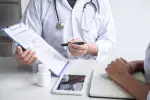In this guide, we’ll cover essential phrases that doctors can use in their daily interactions with Spanish-speaking patients.
1. Greetings and Introduction
Starting with a warm and professional greeting helps build trust with your patients.
- Hola, soy el doctor/la doctora [your name].
(Hello, I am Dr. [your name].) - ¿Cómo se siente hoy?
(How are you feeling today?) - Voy a ser su doctor/doctora hoy.
(I will be your doctor today.)
2. Asking About Symptoms
Getting a clear understanding of the patient’s symptoms is crucial in diagnosing their condition. Here are some basic questions to ask about their symptoms.
- ¿Cuál es el problema principal?
(What is the main problem?) - ¿Dónde le duele?
(Where does it hurt?) - ¿Cuándo comenzaron los síntomas?
(When did the symptoms start?) - ¿El dolor es constante o va y viene?
(Is the pain constant, or does it come and go?) - En una escala del uno al diez, ¿qué tan fuerte es el dolor?
(On a scale of 1 to 10, how strong is the pain?) - ¿Ha tenido fiebre, escalofríos o sudoración?
(Have you had fever, chills, or sweating?)
3. Explaining Diagnosis and Treatment
Once you’ve gathered enough information, it’s important to explain the diagnosis and treatment plan clearly.
- Tiene una infección.
(You have an infection.) - Voy a recetarle algunos medicamentos.
(I am going to prescribe some medications.) - Necesita hacer algunos análisis de sangre.
(You need to have some blood tests done.) - Es posible que necesite cirugía.
(You may need surgery.) - Debe descansar y beber muchos líquidos.
(You should rest and drink plenty of fluids.) - Voy a derivarlo a un especialista.
(I am going to refer you to a specialist.)
4. Reassuring the Patient
Providing reassurance helps in building rapport and can reduce patient anxiety.
- Todo va a estar bien.
(Everything will be fine.) - Estoy aquí para ayudarlo/la.
(I am here to help you.) - Esto es muy común, no se preocupe.
(This is very common, don’t worry.) - Vamos a hacer todo lo posible para que se recupere.
(We will do everything possible to help you recover.)
5. Giving Instructions
Clear instructions ensure patients understand how to follow their treatment plan at home.
- Tome una tableta cada ocho horas.
(Take one tablet every eight hours.) - Aplique esta crema dos veces al día.
(Apply this cream twice a day.) - Debe regresar para una cita de seguimiento.
(You need to come back for a follow-up appointment.) - Evite alimentos grasos y picantes.
(Avoid fatty and spicy foods.) - Si empeora, vaya a la sala de emergencias.
(If it gets worse, go to the emergency room.)
6. Emergency Phrases
In urgent situations, knowing specific emergency-related phrases can be lifesaving.
- Necesitamos llevarlo/la al hospital de inmediato.
(We need to take you to the hospital immediately.) - ¿Puede respirar?
(Can you breathe?) - ¿Tiene alergias a algún medicamento?
(Do you have any allergies to medication?) - Voy a hacerle un electrocardiograma.
(I am going to perform an electrocardiogram.) - Quédese tranquilo/a, por favor.
(Please remain calm.)
7. Discussing Test Results
Explaining test results helps patients understand their health status better.
- Los resultados de su prueba son normales.
(Your test results are normal.) - Los resultados muestran un nivel alto de azúcar en la sangre.
(The results show high blood sugar levels.) - Necesitamos hacer más pruebas para estar seguros.
(We need to do more tests to be sure.)
8. Talking About Medication
Discussing medication is an essential part of the consultation.
- Este medicamento puede causar algunos efectos secundarios.
(This medication may cause some side effects.) - Asegúrese de tomar este medicamento con alimentos.
(Make sure to take this medication with food.) - No suspenda el tratamiento sin consultarme.
(Do not stop the treatment without consulting me.)
9. Follow-up and Discharge Instructions
Clear discharge instructions ensure patients know how to continue their care.
- Debe regresar en dos semanas para un chequeo.
(You should come back in two weeks for a check-up.) - Si tiene algún problema, llame a la clínica.
(If you have any problems, call the clinic.) - Es muy importante que siga estas instrucciones.
(It’s very important that you follow these instructions.)
Conclusion
Having these common medical phrases in Spanish ready can bridge the communication gap between doctors and their Spanish-speaking patients, ensuring better understanding, trust, and care outcomes. Learning these basic phrases will not only enhance your ability to treat patients more effectively but also improve their experience and comfort during medical consultations.
If you’re interested in improving your medical Spanish, consider using language learning apps or enrolling in a Spanish course tailored for healthcare professionals. Your ability to communicate in Spanish could make all the difference in providing the best care possible.

